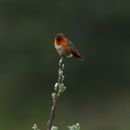zh-TW
在導航的名稱


Prolonged hovering and flying backwards are unique to hummingbirds. This amazing flight ability requires huge amount of food (caloric input) in order to sustain the flights. This is why hummingbirds have to constantly be feeding during the day and go torpid at night. If a human used energy at the rate that a hummingbird does, he/she would have to consume about four hundred pounds of potatoes and a thousand quarter-pound hamburgers every day.
(Arizona-Sonora Desert Museum 1998)
Perception Channels: visual ; tactile ; acoustic ; chemical
US Federal List: no special status
CITES: appendix ii
IUCN Red List of Threatened Species: least concern
There is neither positive nor negative economic importance for the Allen's Hummingbird, but they do help in the pollination of flowers.
Allen's Hummingbird has a long narrow bill and long tongue. This feature allows it to obtain nectar from flowers. They feed every ten to fifteen minutes and visit approximately 1,000 flowers a day. Nectar is their main source of energy, but they also obtain protein from small insects like flies, ants, small beetles, tiny wasps, and other small insects. Because the hovering flight used by these birds to gather nectar requires phenomenal amounts of energy, the Allen's hummingbird has to consume over twice its weight of nectar each day.
(Cassidy 1990, Arizona-Sonora Desert Museum 1998, Stokes 1989)
Allen's Hummingbird, Selasphorus sasin, is a migratory bird which summers along the pacific coast of the United States from Oregon to southern California. During the winter it migrates to northwestern Mexico.
(Peterson 1990, Terres 1980)
Biogeographic Regions: nearctic (Native )
The Allen's Hummingbirds can be found in bushy woods, gardens, flower filled mountain meadows, and parks.
(Cassidy 1990, Stokes 1996)
Terrestrial Biomes: savanna or grassland ; forest
Average lifespan
Status: wild: 48 months.
Allen's Hummingbirds are among the smallest birds, they are only 7.5 to 9 cm (3-3.5 in.) long and typically weigh a little over 3 grams (0.1 oz.). In appearance they resemble their closest relative, the Rufous Hummingbird. A male Allen's hummingbird has a fiery red-orange throat, white collar, and metallic green on its back and cap. The female's upper body is green. The tail and sides are orange-brown and the throat and central belly is white with iridescent dots on its throat.
(Stokes 1996, Farrand 1988, Terres 1980)
Average mass: 3 g.
Other Physical Features: endothermic ; bilateral symmetry
Average mass: 3 g.
Average basal metabolic rate: 0.06853 W.
Female Allen's hummingbirds usually start building their nest before they mate. After mating the female alone has to finish the half built nest. She uses moss, bits of vegetation, spider webs, bark flakes, and pine needles to finish the cup-shaped nest. This nest is only about 4 cm (1.5 in.) from top to bottom and 4-5 cm (1.5-2 in.) in diameter. She lays only two eggs, which are about 1 cm (1/2 in.).
The female alone incubates the eggs for about 16 to 22 days. Once the baby hummingbirds are hatched, the mother fearlessly protects her young. She alone has the duty to feed them until they are ready to leave the nest. She feeds them by inserting her bill into the baby's mouth and regurgitating food from her crop. Chicks usually fledge (leave the nest) in about 22 days and are immediately independant of their mother.(Baicich 1997, Ehrlich 1988, Terres 1980, Stokes 1989)
Key Reproductive Features: iteroparous ; gonochoric/gonochoristic/dioecious (sexes separate); sexual ; oviparous
Average time to hatching: 16 days.
Average eggs per season: 2.